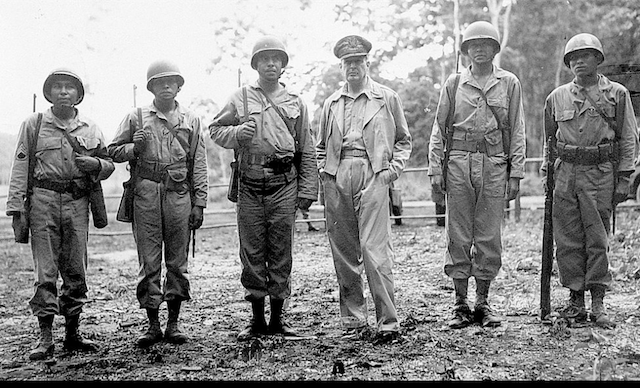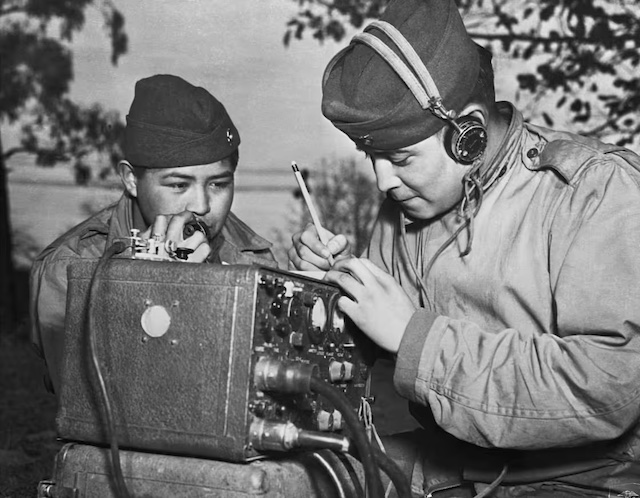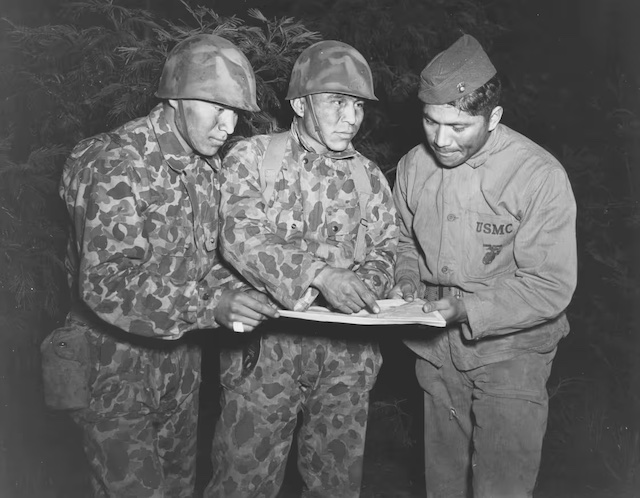The Navajo code, based on the language of the Navajo Nation, was considered unbreakable.
 The United States’ Navajo code secured victories at major turning point battles and remained unbroken by the end of World War II. But it wasn’t a series of random, encrypted characters — it was a pre-existing language.
The United States’ Navajo code secured victories at major turning point battles and remained unbroken by the end of World War II. But it wasn’t a series of random, encrypted characters — it was a pre-existing language.
During the war, the U.S. Marine Corps enlisted members of the Navajo Nation, a Native American population and reservation in what is now Utah, Arizona and New Mexico. Their originally unwritten language became the basis of a code that was used in most Marine operations in the Pacific Theater, according the U.S. Intelligence Community, a group of federal agencies dedicated to national security.
The code, which assigned a Navajo word to key military phrases, allowed for faster translations — the code breakers could decipher lines in 20 seconds, compared to 30 minutes, the IC states. The code was never broken.

A two-man team of Navajo code talkers attached to a Marine regiment in the Pacific relay orders over the field radio using their native language.
Here’s what to know about the Navajo code talkers and their key role in WWII.
Who Were the Navajo Code Talkers?
The Navajo code talkers were a group of 29 men who created a code based on their language.
The code-talking program is described as the “brainchild” of a man named Philip Johnston, 2008 article on the CIA’s website states. Johnston, a child of missionaries, grew up on the Navajo reservation and knew the language. So in 1942, when the U.S. was looking for a code, he thought of Navajo and its unique complexity.

A group of Marines and members of the Navajo Nation study a night problem at a scout school in June 1943. They were attached with the 1st Marine Division in the Southwest Pacific.
Chester Nez, one of the creators of the code who died in 2014, started attending a Bureau of Indian Affairs boarding school at 8 years old, the New York Times reported in his obituary. At this school, students were forced to assimilate. Speaking Navajo was forbidden, and punishments included beatings or having their mouths washed out with soap.
“When joining the Marine Corps, I thought about how my people were mistreated,” Nez said in a 2005 interview, per the New York Times. “But then I thought this would be my chance to do something for my country.”
The 29 men in the first group of recruits, including Nez, were tasked with creating a code based on the Navajo language. Once the code was created, an estimated 400 members of the Navajo Nation participated in the program, according to the CIA.
One of the key victories credited to the code talkers was the Battle of Iwo Jima, which occurred from Feb. 19 to March 26, 1945. Six Navajo code talkers worked throughout the U.S.’s invasion, sending more than 800 messages, according to the CIA.
The original Navajo code talkers were:
* Charlie Sosie Begay
* Roy Begay
* Samuel H. Begay
* John A. Benally
* Wilsie H. Bitsie
* Cosey S. Brown
* John Brown Jr.
* John Chee
* Benjamin Cleveland
* Eugene R. Crawford
* David Curley
* Lowell S. Damon
* George H. Dennison
* James Dixon
* Carl N. Gorman
* Oscar B. Ilthma
* Allen D. June
* Alfred Leonard
* William McCabe
* James Manuelito
* Chester Nez
* Jack Nez
* Lloyd Oliver
* Frank D. Pete
* Joe Palmer (AKA, Balmer Slowtalker)
* Nelson S. Thompson
* Harry Tsosie
* John Willie
* William Yazzie
What Is the Navajo Code?
The Navajo code involved turning military terms into Navajo words and creating an alphabet out of the language. They used word substitution within the Navajo language to further encrypt each message, according to the CIA.
Nez told CNN in 2011 that the code used “everyday Navajo words” to ensure they could remember it.
“Still, I worried every day that I might make an error that cost American lives,” he said. “But our code was the only code in modern warfare that was never broken. The Japanese tried, but they couldn’t decipher it. Not even another Navajo could decipher it if he wasn’t a code talker.”
The code and the work of the code talkers was declassified in 1968. The U.S. Naval History and Heritage Command website has a detailed code talkers’ dictionary, a cypher for names of planes, countries, military titles, months and more as they were used during the war. For example, “division” was encoded to “ashih-hi,” which literally translates to “salt,” according to the dictionary. “Da-gha-hi,” literally “bread,” translates to “France.”
What Happened to the Navajo Code Talkers After World War II?
During the war, the code talkers were noted for their work. Major Howard Connor, a Marine signal officer during the Battle of Iwo Jima, wrote in a report that “without Navajo, Marines would never have taken the Island of Iwo Jima,” according to a Library of Congress blog post.
But the code talkers’ work was classified, and it wasn’t until 23 years after the end of the war that the people who participated in the program could tell the world about it, code talker Peter MacDonald told the Navy Office of Information in 2021.
“If anyone asked us what we did in war, we were to say, ‘I was a radioman’ that’s all, nothing more,” MacDonald said.
MacDonald said, for example, some went to the livestock economy and others attended to school using GI bill benefits.
According to a 2021 research guide on the Library of Congress website, some experienced discrimination. The Snyder Act granted citizenship to Native Americans in 1924, but Navajo members weren’t allowed to vote in the states where Navajo land is located until after the war. Navajo members were denied service at hotels and restaurants off the reservation, and there were hurdles to using veterans’ benefits, according to the 2021 research guide.
Recognition of the service of the Navajo code talkers wasn’t acknowledged until after their work was declassified. According to the Library of Congress research guide, President Richard Nixon sent certificates of appreciation to the Navajo Tribal Council in 1971, and in 1982, President Ronald Reagan made Aug. 14 National Navajo Code Talkers Day, an occasion that stands today. In 2000, a law to honor the Navajo code talkers passed in Congress, awarding the first 29 code talkers a Congressional Gold Medal.
Are Any Navajo Code Talkers Still Alive?
Of the Navajo code talkers just two men, Thomas H. Begay and Peter MacDonald, are still alive, according to the Associated Press..
Just weeks before the start of National Native American Heritage Month in November, code talker John Kinsel Sr. died at 107.
Where can I learn more?
Countless articles, blog posts and books have been written about the Navajo code talkers. Here are some recommendations:
* Profiles and oral histories of code talkers, compiled by the Library of Congress
* The Arizona Republic’s Navajo Code Talkers: The last of the living WWII heroes share their stories
Written by Maddie Ellis for Today, November 22, 2024
